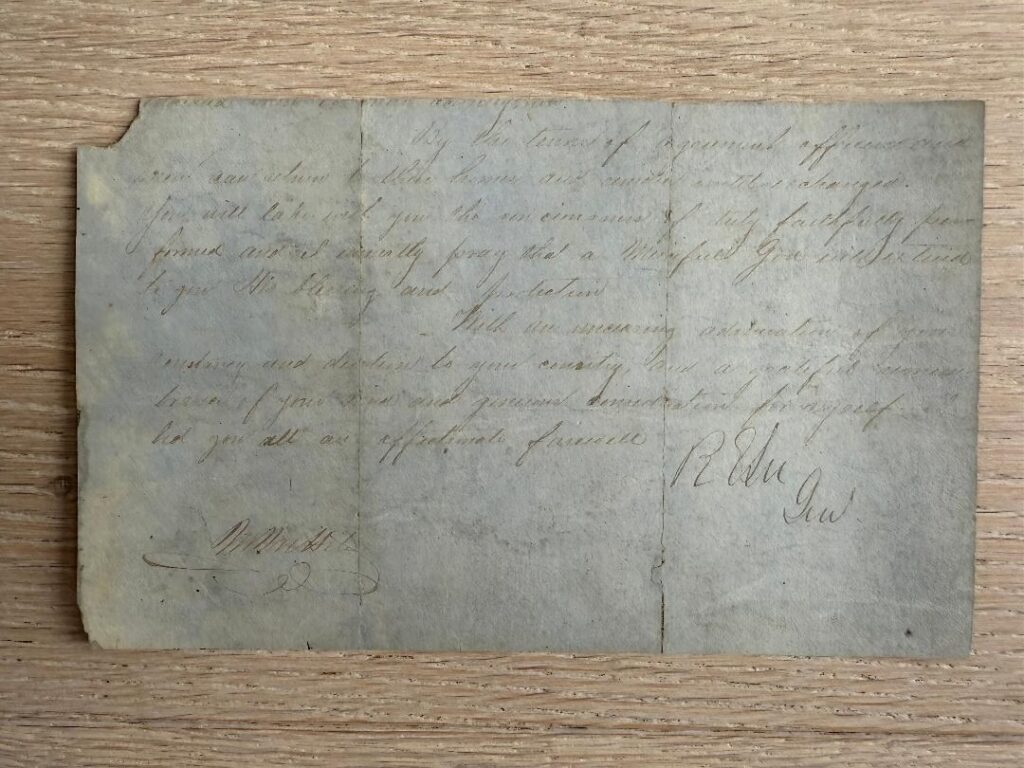ROBERT E. LEE SIGNED FRAGMENT OF HIS FAMOUS FAREWELL ADDRESS TO HIS TROOPS, GENERAL ORDER NUMBER 9.
Historic manuscript document signed of Lee’s iconic General Order No. 9 signed (“R.E. Lee Genl.”), 1 page (4 x 5 in.), on grey stationery, “Headquarters, Army N. Va.”, [Appomattox Court House, 10 April 1865], being the concluding paragraphs of the transcript, penned in an unknown hand, of Robert E. Lee’s farewell message address to the Army of Northern Virginia written a few hours after he had surrendered to General Ulysses S. Grant at Appomattox Court House, effectually ending the Civil War. Areas of text are light, but fully legible; small separation on right vertical fold. General Robert E. Lee’s eloquent farewell to his vanquished army, marking the end of the Civil War. The document originally read in full: Headquarters, Army N. Va. General Order No. 9. After four years of arduous service, marked by unsurpassed courage and fortitude the Army of Northern Virginia has been compelled to yield to overwhelming numbers. I need not tell the survivors of so many hard fought battles who have remained steadfast to the last, that I have consented to this result from no distrust of them. But feeling that valor and devotion could accomplish nothing that would compensate the loss that would attend the continuance of the contest, I determined to avoid the useless sacrifice of those whose past services have endeared them to their countrymen. Our document contains the concluding paragraphs of the Farewell Address as follows: “By the terms of the agreement, officers and men can return to their homes and remain until exchanged. You will take with you the satisfaction that proceeds from the consciousness of duty faithfully performed, and I earnestly pray that a merciful God will extend to you His blessing and protection. With unceasing admiration of your constancy and devotion to your country and a grateful remembrance of your kind and generous consideration of myself, I bid you an affectionate farewell. [signed] R.E. Lee Genl”.
Left with no route of escape after the fall of Petersburg, Virginia, on 2 April 1865, Confederate General Robert E. Lee was faced with a difficult choice: keep fighting in an increasingly hopeless war or surrender to Ulysses S. Grant. At 4 a.m. on 9 April, Major General Edward O.C. Ord, commander of the Army of the James, arrived with the XXIV Corps to support the Union forces and Lee’s fate was decided. Lee wrote to Grant and asked to meet to discuss terms of surrender. Throughout the morning, as communications concerning the surrender flew back and forth between Grant and Lee, their troops were still fighting at Appomattox Court House. Shortly before noon, Lee sent a message to Grant’s lines asking for a “suspension of hostilities pending the discussion of the Terms of surrender of this Army.” It was received and recorded by General Ord, who wrote on it: “men at rest – firing stopped.” By the end of the day, Lee had accepted Grant’s terms for surrender. Lee’s General Order No. 9 – his farewell to his troops – was drafted the day after Lee’s surrender to Grant at Appomattox Court House. Col. Charles Marshall, Lee’s military secretary, recalled the circumstances under which the document was composed: “On the night of April 9th…General Lee sat with several of us at a fire in front of his tent, and after some conversation about the army and the events of the day in which his feelings toward his men were strongly expressed, he told me to prepare an order to the troops…” On the next day (10 April), Marshall was subject to so many interruptions that he was unable to find the time to write out the requested draft until about 10 o’clock. Lee, discovering that the order had not yet been prepared, directed Marshall to get into his ambulance (which stood near his tent) and placed an orderly “on guard” to prevent anyone from approaching him while he prepared the order. The first draft was executed by Marshall in pencil. He took it to Lee, who struck out a paragraph (which he said would tend to keep alive the ill-feeling existing between the North and the South), and also made one or two other word changes. Marshall returned to the ambulance, where he wrote a revised draft which he gave to a clerk in the office of the Adjutant General to write out in ink. Before the day was over, Lee signed the revised draft, as well as the additional copies made by various hands for transmittal to corps commanders and chiefs of the bureaus of the general staff. Other individuals made their own copies which were brought to General Lee to sign as souvenirs. Copies came to be treasured souvenirs among generations of Southerners. Most surviving copies are in generally poor condition, having suffered the effects of repeated handling and admiration by those who were so moved by Lee’s eloquent words. General Order No. 9 remains as one of the best-known documents of the entire Civil War. Although only a partial document and significantly faded, this document is a rare treasure, bearing the signature of the great general.




